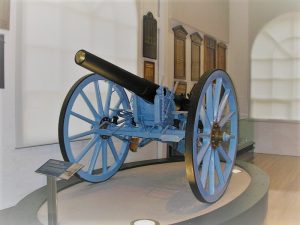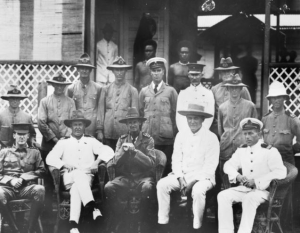- Author
- Editorial Staff
- Subjects
- Biographies and personal histories, History - WW1
- Tags
-
- RAN Ships
- HMAS Berrima
- Publication
- March 2016 edition of the Naval Historical Review (all rights reserved)
The manuscript of Read’s diary was acquired by the Mitchell Library in 1919 for the sum of £30. It lay undisturbed for nearly a century until transcribed into digital format in 2014. The 137 page manuscript contains a fascinating level of detail important both to naval history and that of New Guinea. As the University of Papua New Guinea Press has received permission from the Mitchell Library to reproduce the diary they asked the Naval Historical Society to provide a foreword to the new publication (shown below).

The following minor extract from the diary provides an indication of what can be found in such documents. Many readers will recall a captured WWI German field gun displayed in the Naval Heritage Centre at Garden Island. The history of this gun has remained obscure. However Read’s diary provides some answers when he tells us of his visit to Government House at Rabaul on Friday 18 September 1914 where his No 2 Company of Naval Reserves were erecting aerials for a radio station.
Government House is a quaintly built comfortable dwelling surrounded on all sides by broad balconies, the whole raised 8 feet from the ground. Our troops had shown little respect for the fine furniture in the drawing room and bedrooms and it was enough to make the heart bleed to see exquisite carvings of the cabinets, bookcases, sideboards etc. ruthlessly destroyed by the bayonets and clubbed rifles of the intruders.
The following day Read adds:
While at Government House yesterday we came across two German field guns cast down by some blundering idiot into a steep gully where the carriage of one of them has been irreparably damaged. The other, however, is intact. We have obtained permission to reclaim them and bring them on board Berrima. Our lads at work on the wireless mast are eager to recover them and Munro proposes that as our party were the discoverers we should bring them into town.
In collaboration of Read’s comments there were a number of unsavoury incidents regarding looting by troops in New Guinea with, for example, a report by Colonel Homes to Army Headquarters stating:
On the night of the 13thinstant some looting took place at Government House by part of a Company on outpost duty on a hill in the vicinity, and troops there apparently got somewhat out of hand. I am inclined to think on account of want of proper supervision by the officers concerned.
These unfortunate incidents appear mainly confined to unruly militia and discipline was better preserved within naval ranks.
Foreword to the Clarence Hansby Read Diary
Clarence Hansby Read was born in the Sydney suburb of Darlinghurst on 7 October 1879 (the exact date was extrapolated from his diary which mentions his birthday). He appears to have been schooled for some while in the Blue Mountains as his name appears in the Glenbrook Primary School WWIRoll of Honour. Later records show his profession as a clerk and after his marriage to Mabel Louisa Coates on 22 May 1907, the couple resided at ‘Kenilworth’, Pine Street, Randwick.
The earliest record of his naval service so far found is a Commonwealth Naval Forces List dated October 1905 where he is shown as SBLT C.H. Read of the Naval Militia Sydney with a seniority of 01 August 1902. A later Imperial Service Record from January 1916 says he was then aged 36 years and 4 months with 19 years and 6 months prior naval service indicting he was born in October 1879 and joined the Naval Brigade in about 1896. Reserve Officer training records show he was promoted to SBLT on 01 August 1902 after serving six years as a MIDN, promoted LEUT 01 April 1912 and LCDR 01 April 1920. The training record ceases with the Royal Australian Naval Brigade being officially disbanded on 30 June 1920. The above indicates he joined the Naval Brigade on or about 01 August 1896 just before his 17th birthday. He served in the Brigade with distinction for nearly 24 years.
A contemporary two years Read’s junior for whom we have better records was Leighton Bracegirdle. He joined the NSW Naval Brigade in 1898 as a cadet and two years later was promoted to midshipman. Bracegirdle was also from Sydney and employed as a clerk. He was to win fame as the commanding officer of the Naval Bridging Train employed at the Dardanelles. In due course he became Rear Admiral Sir Leighton Bracegirdle.
Lieutenant Read, RANR (M), joined HMAS Berrima in charge of No 2 Company of the NSW Naval Brigade as part of the Australian Naval and Military Expeditionary Force (AN&MEF) bound for German New Guinea in September 1914. He was involved in the capture of Kaiser Wilhelmsland and from 24 September to 31 December 1914 commanded the naval detachment stationed at Madang and then transferred to Herbertshohe (Kokopo) where he served briefly as executive officer of the naval detachment from 19 January to 10 February 1915.
On 10 February 1915 Read returns from Rabaul with 726 troops plus 313 naval forces in the transports Easternand Navua; the naval forces were accommodated in the latter vessel. They arrived to a warm reception in Sydney on 19 February; unfortunately the Read diary ends here. Nineteen female nurses enlisted with the AN&MEF and were employed at the Namanula Hospital at Rabaul; it is assumed they also returned with their patients, many suffering from malaria, in the Eastern.

A photograph on page 73 of the Official History of Australia in the War of 1914 -18Vol. X shows men of the Naval Reserve and Machine-Gun Section, 1st Battalion, AN&MEF. In front are five officers including LCDR Bracegirdle and LEUT Read. A further official photograph showing officers serving in New Guinea shows LEUT Read standing with pith helmet on the far left.
Following his return to Australia he was amongst those chosen to form the 1st Australian Bridging Train of 12 officers and 304 ratings which was mobilised in Melbourne from personnel of the Naval Brigade drawn from all states. In March 1916 he embarked in HMAT Ballarat for her voyage to Suez with the Naval Bridging Train. Read was posted as second in command to Bracegirdle. They served together in Egypt constructing wharves and piers for shipment to the Dardanelles and for a while Read assumed command while Bracegirdle was hospitalised with malaria. Read also succumbed to disease and a nervous disorder and was hospitalised in Egypt for two months in early 1917.
With work on the successful evacuation of troops from Gallipoli completed there was less work for the Bridging Train and sections were often lent to numerous other units. In early 1917 a decision was made to disband the Bridging Train and members were offered the choice of being posted to other units of the AIF mainly serving in France or to return home. About half chose to continue in the AIF and Read was amongst the remainder who opted to return home.
On 29 May 1917 Read, with about 120 other men from the Bridging Train, embarked in the transport Bulla at Suez and arrived in Melbourne on 8 July, and at the end of the month he was demobilised. For his efforts Read was awarded the British War Medal, the Victory Medal and, the 1914-15 Star. Nearly three years later, in April 1920, he received notice of his promotion to LCDR RANR.
This remarkable man, whose history is important to the formation of the RAN, has only recently come to notice as his diary of his time with the AN&MEF which was deposited with the Mitchell Library was transcribed and digitised only in 2014. This helps fill many gaps to our knowledge of early naval campaigns especially in the capture and control of mainland New Guinea centred on Friedrich Wilhelmshafen (Madang) and extending to Berlinhafen (later Eitape, now Aitape) in the north to Adolfhafen (Morobe) in the south.
A copy of LCDR Read’s diary can be found on the following website:
http://acms.sl.nsw.gov.au/_transcript/2014/D24942/a6722.html




